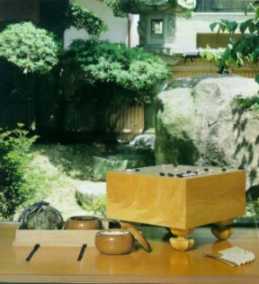

. . . [it is] something unearthly . . . If there are sentient beings on other planets, then they play Go.
Go uses the most elemental materials and concepts -- line and circle, wood and stone, black and white -- combining them with simple rules to generate subtle strategies and complex tactics that stagger the imagination.
There are on the Go board 360 intersections plus one. The number one is supreme and gives rise to the other numbers because it occupies the ultimate position and governs the four quarters. 360 represents the number of days in the [lunar] year. The division of the Go board into four quarters symbolizes the four seasons. The 72 points on the circumference represent the [five-day] weeks of the [Chinese lunar] calendar. The balance of Yin and Yang is the model for the equal division of the 360 stones into black and white.
Monks who have a talent for it play go with women and become their lovers.
The board has to be square, for it signifies the Earth, and its right angles signify uprightness. The pieces of the two sides are yellow and black; this difference signifies the Yin and the Yang -- scattered in groups all over the board, they represent the heavenly bodies. These significances being manifest, it is up to the players to make the moves, and this is connected with kingship. Following what the rules permit, both opponents are subject to them -- this is the rigor of the Tao.
Beyond being merely a game, to enthusiasts Go can take on other meanings: of a nature analogous with life, an intense meditation, a mirror of one's personality, an exercise in abstract reasoning, or, when played well, a beautiful art in which Black and White dance across the board in delicate balance.
Unlike chess and its different pieces and complicated rules, Go is played with black and white stones equal in value, seemingly making it compatible with the binary nature of computers. Since the aim of a move is to control the most territory, the optimal move yields the maximum amount of territory -- a simple counting procedure and a chore computers excel at. Yet in spite of the efforts of the world's best programmers over the last 30 years, the level of computer Go remains about that of a human who has studied Go for a month.
Studying go is a wonderful way to develop both the creative as well as the logical abilities of children because to play it both sides of the brain are necessary.
The difference between a stone played on one intersection rather than on an adjacent neighbor is insignificant to the uninitiated. The master of Go, though, sees it as all the difference between a flower and a cinderblock. Certain plays resonate with a balletic grace, others clunk, hopelessly awkward, and to fail at making the distinction is a bit like confusing the ping of a Limoges platter with the clink of a Burger King Smurfs tumbler.
That play of black upon white, white upon black, has the intent and takes the form of creative art. It has in it a flow of the spirit and a harmony of music. Everything is lost when suddenly a false note is struck, or one party in a duet suddenly launches forth on an eccentric flight of his own. A masterpiece of a game can be ruined by insensitivity to the feelings of an adversary.
Go is to Western chess what philosophy is to double entry accounting.
Those interested in impressing others with their intelligence play chess. Those who would settle for being chic play backgammon. Those who wish to become individuals of quality, take up Go.
There are Oriental folk tales reminiscent of Rip Van Winkle in which people have been stopped by an old man [one of the Immortals], played a game of Go, and upon getting up from the board have found a hundred years have gone by. This purely mental aspect of the game is in its intellectual dynamic. These Chinese had seen it as encompassing the principles of nature and the universe and of human life, as the diversion of the immortals, a game of abundant spiritual powers.
You're striving for harmony, and, if you try to take too much, you'll come to grief.
About three hundred years ago an eminent Chinese monk came to Japan on a visit and was shown the diagram of a game of Go which a master of that time had recently played. Without knowing anything of the game save the sketchy description they gave him, the monk studied the moves as shown on the record, and after a few moments remarked with much admiration and respect that the player must have been a man who had become enlightened, which was indeed the case. It is interesting to note that this story is told on the one hand by Go players to illustrate the quality of the game and on the other hand by Buddhists to show the acuity of the monk from China.
The board is a mirror of the mind of the players as the moments pass. When a master studies the record of a game he can tell at what point greed overtook the pupil, when he became tired, when he fell into stupidity, and when the maid came by with tea.